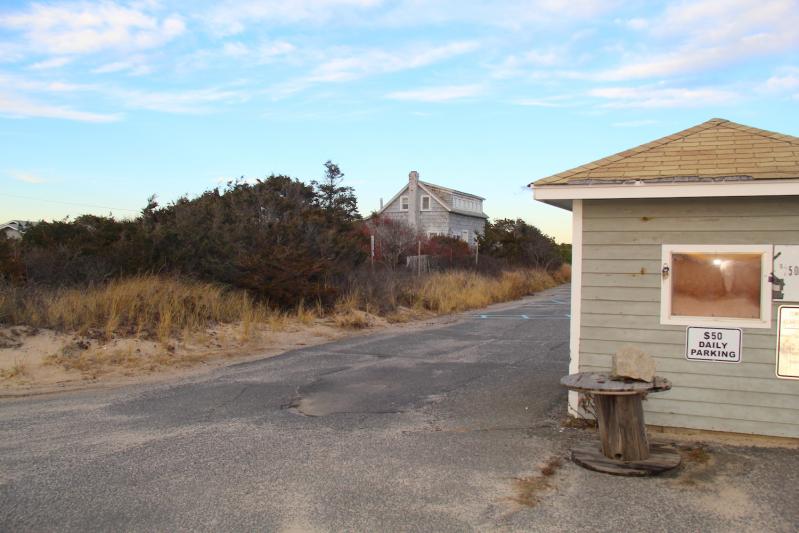The East Hampton Town Zoning Board of Appeals held a heated public hearing last week on an application by Farrell Builders to demolish a beach cottage, unchanged since the early 1970s, and construct a new house at 175 Atlantic Avenue in Amagansett. The Z.B.A. had denied a similar application four years ago, and this one showed only minor changes from that one.
The board heard from 24 town residents, who either wrote letters or spoke out at the meeting, all strongly opposing the application. Not one public comment was made in support.
The existing cottage, a 1,400-square-foot, three-bedroom, one-and-a-half story house, which was built before zoning laws were established, was sold to Farrell in 2017 for $2.3 million. In 2018, the developer sought to replace it with a 3,790-square-foot, two-story house, with a deck, pool, patio, accessory structure, driveway, and new sanitary system.
To do so, Farrell needed a natural resources special permit from the Z.B.A.: The old house was built in the dunes, necessitated excavation, and required the installation of a septic system. The 2018 board, however, was unanimous in its denial.
“The project seems to be designed to nearly maximize the development of any lot of this size, regardless of the presence of dune land habitat and vegetation,” its decision said. “This proposed lot coverage exceeds the constraints of this environmentally sensitive lot.” Not only that, but “the proposed building would not “maintain the established character of the neighborhood, nor does it contribute to the orderly growth of the neighborhood.”
“It does not appear that much effort was put into minimizing the amount of clearing or the size and extent of proposed improvements,” the board concluded.
Nonetheless, despite the lack of approval, the property was listed on the Farrell website a few days before last week’s hearing as a “pre-completion” offering, for just short of $20 million.
Liz Vail, the attorney representing Farrell (she is also the Sag Harbor Village attorney), tried hard to draw a distinction between the previous application and the new one. “It’s in keeping with the character of the community and the neighborhood,” which, she argued, has been improved in recent years with similar residences.
Farrell had made “significant reductions,” she said, in the gross floor area, taking it from 3,790 down to 3,240 square feet. Overall lot coverage had been reduced as well, Ms. Vail said, noting that the project would not require setback variances. She said that only one house, directly to the north, would be affected.
The lot in question directly overlooks the big parking lot at Atlantic Avenue Beach, and several critics had compared it to the structure rising from the ashes of the East Deck Motel at Ditch Plain in Montauk. Ms. Vail, however, dismissed potential complaints from beachgoers.
“The board should not give greater weight to those people parking at a very large beach . . . whose intent is to go to the ocean, and who may or may not notice this house,” she said.
In fact, she asked that the board not even consider such objections. “If you don’t live next to the property, you’re not impacted in that specific way this board is supposed to consider.”
Critics disagreed. Monica Rich wrote to the board that “We don’t want to be ‘ditched.’ What was allowed to happen and ruin Ditch Plains Beach . . . cannot be allowed to happen in Amagansett. Please do not make the same mistake twice! Do not allow a freakishly big house to ruin the character of another well-loved beach in East Hampton Town.”
“In the 2019 determination, there was big discussion with the zoning board regarding the character of the neighborhood,” noted Roy Dalene, the Z.B.A. chairman. He pushed back at Ms. Vail’s assertion that the Farrell house would fit right in.
“It’s truly an area where there are beach cottages within the dunescape . . . and then we have the bird sanctuary, we have the Life-Saving Station . . . and a historic district. The character of this neighborhood has existed for a very long time. It’s a stretch to consider this as part of the character of the neighborhood.”
“The whole goal of zoning is to eliminate nonconformities,” Ms. Vail responded. “We’re taking what’s a pre-existing nonconformity and making it conforming. . . . The entire structure is well under zoning.”
“Conformity is one thing, but the natural resources special permit and intent of town code is another thing we have to weigh,” said Mr. Dalene. The town code, he said, clearly seeks to protect vistas, dunelands, and the existing character of neighborhoods.
“The current application is very similar to that 2019 determination,” said Tyler Borsack, an environmental analyst with the Planning Department. It is “still fairly sprawling,” and “unrealistic” in its clearing envelope. “Incidental clearing,” he said, would most likely occur.
“It will dominate and degrade the largest and one of the most important areas of public beach access in the town of East Hampton,” said Jaine Mehring, summarizing a long letter she’d sent to the board. (Ms. Mehring had highlighted the proposal on her Instagram page, @build.in.kind_easthampton.)
Among other things, she found the proposed conversion of 550 square feet of living area to storage space unconvincing. “It’s reasonable to foresee it transforms into a habitable living area,” she said. “Let this one go,” she urged the board. “Farrell companies have been a smashing success and has built well over 400 luxury houses in the Hamptons. This half acre means much more to hundreds, if not thousands, of us, than it will ever mean to you.”
“Somebody has to take a stand,” said Rona Klopman, president of the Amagansett Citizens Advisory Committee, calling in. “We’re counting on you to preserve our scenic areas.”
“The simple ranch-style beach house currently there dialogues perfectly with its surroundings, including the historic Life-Saving Station across the street, the Amagansett National Wildlife Refuge, and the Bluff Road Historic District down the road,” wrote Irwin Levy in a letter to the board.
“Rather than contributing to our community with a sensitive, respectful redevelopment, this application seeks to extract from our community instead; the only concern being return on investment — flora, fauna, and community be damned. So very unfortunate,” he wrote.
Ms. Vail had read all the letters, she told the board, but was unmoved. “A special permit cannot be denied solely because of general community objections, community pressure, or speculation,” she said. “A decision to deny an application solely because the residents of an area oppose an application is certain to be annulled.”
The public hearing will remain open for written submissions through Tuesday.
The East Hampton Town Trustees discussed the project on Monday, given that the trustees own the parking lot next door.
“If we, as the adjacent property owners, are not wild about what’s going in there and it does get permitted, it’s within our rights to screen it” with plantings, Trustee Jim Grimes said, lamenting that the plantings would come out of the trustees’ budget.
Although some of his colleagues expressed personal opinions — including Bill Taylor’s comment that “if they don’t bitch about our parking lot, we won’t bitch about their house” — the group ultimately voted to notify the Z.B.A. that it has nothing specific to say on the merits of the project.




